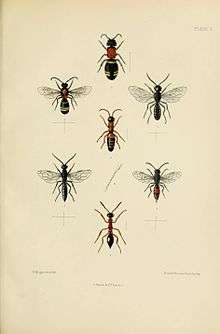Myrmosidae
The Myrmosidae are a small family of wasps very similar to the Mutillidae. As in mutillids, females are flightless, and are kleptoparasites in the nests of fossorial bees and wasps.
| Myrmosidae | |
|---|---|
 | |
| Edward Saunders, 1896 The Hymenoptera Aculeata of the British Islands : a descriptive account of the families, genera, and species indigenous to Great Britain and Ireland, with notes as to habits, localities, habitats London :Reeve,1896.Plate 7 with 3 and 4 being male and female Myrmosa melanocephala | |
| Scientific classification | |
| Kingdom: | Animalia |
| Phylum: | Arthropoda |
| Class: | Insecta |
| Order: | Hymenoptera |
| Superfamily: | Pompiloidea |
| Family: | Myrmosidae Fox, 1894 |
| Genera | |
|
See text | |
Taxonomy
Recent classifications of Vespoidea (beginning in 2008) concluded that the family Mutillidae contained one subfamily that was unrelated to the remainder, and this subfamily was removed to form a separate family Myrmosidae.[1][2] Myrmosids can be readily distinguished from mutillids by the lack of abdominal "felt lines" in both sexes, and the retention of a distinct pronotum in females (pronotum fused to metanotum in mutillids).
Genera
- Carinomyrmosa
- Erimyrmosa
- Krombeinella
- Kudakrumia
- Leiomyrmosa
- Myrmosa
- Myrmosina
- Myrmosula
- Nothomyrmosa
- Paramyrmosa
- Protomutilla
- Pseudomyrmosa
References
- Pilgrim, E.; von Dohlen, C.; Pitts, J. (2008). "Molecular phylogenetics of Vespoidea indicate paraphyly of the superfamily and novel relationships of its component families and subfamilies". Zoologica Scripta. 37 (5): 539–560. doi:10.1111/j.1463-6409.2008.00340.x.
- Johnson, B.R.; et al. (2013). "Phylogenomics Resolves Evolutionary Relationships among Ants, Bees, and Wasps". Current Biology. 23 (20): 2058–2062. doi:10.1016/j.cub.2013.08.050. PMID 24094856.
External links
This article is issued from Wikipedia. The text is licensed under Creative Commons - Attribution - Sharealike. Additional terms may apply for the media files.